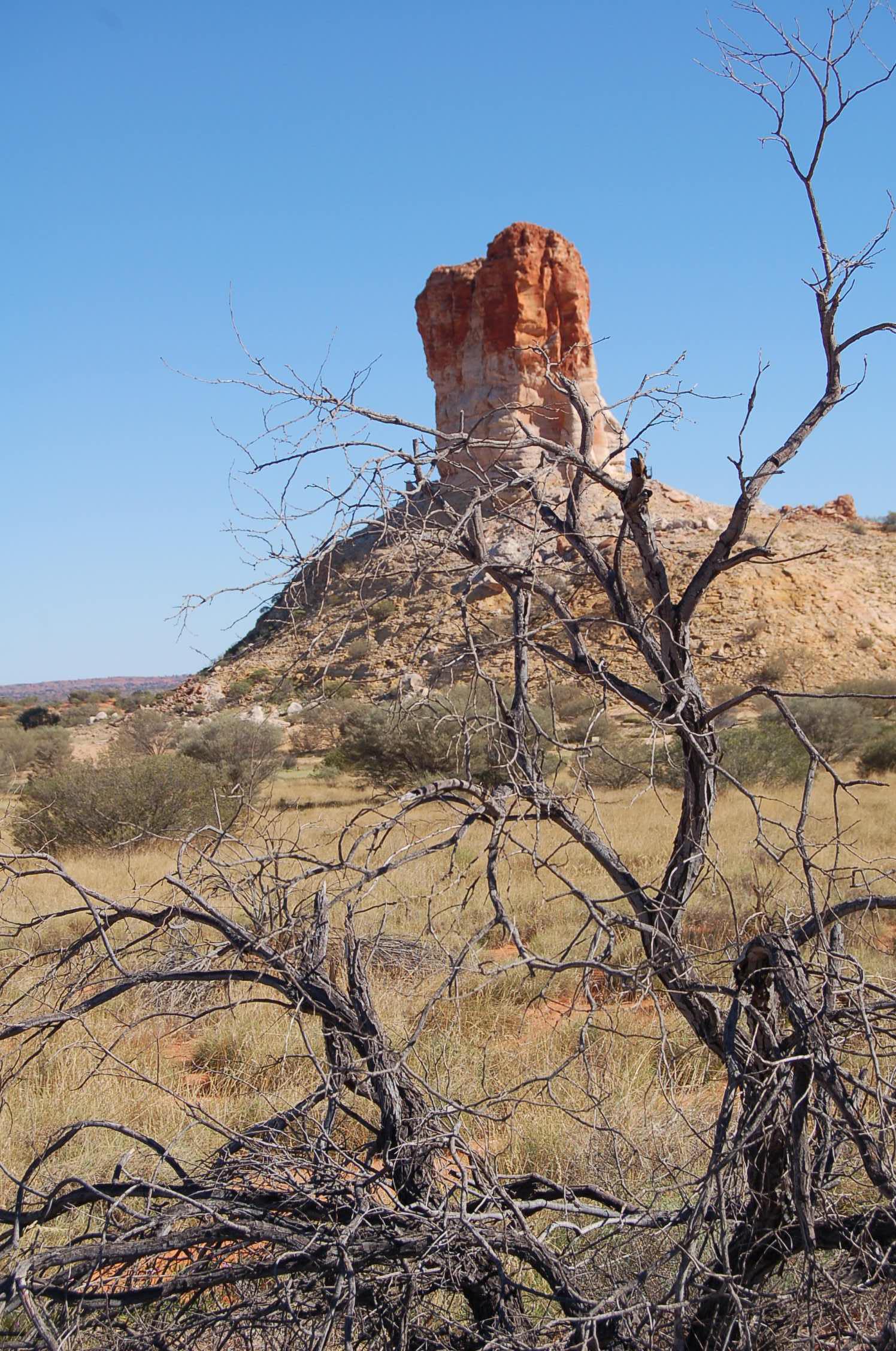Chambers Pillar on:
[Wikipedia]
[Google]
[Amazon]

 Chambers Pillar (Aboriginal name ''Idracowra'' or ''Etikaura'') is a
Chambers Pillar (Aboriginal name ''Idracowra'' or ''Etikaura'') is a
Fact Sheet: Chambers Pillar Historical Reserve
(Parks and Wildlife Commission NT) {{Coord, 24, 52, S, 133, 49, E, type:landmark_region:AU-NT, display=title Landforms of the Northern Territory Rock formations of Australia
sandstone
Sandstone is a clastic sedimentary rock composed mainly of sand-sized (0.0625 to 2 mm) silicate grains. Sandstones comprise about 20–25% of all sedimentary rocks.
Most sandstone is composed of quartz or feldspar (both silicates ...
formation some south of Alice Springs in the Northern Territory of Australia
The Northern Territory (commonly abbreviated as NT; formally the Northern Territory of Australia) is an Australian territory in the central and central northern regions of Australia. The Northern Territory shares its borders with Western Aust ...
.
Formation
Erosion
Erosion is the action of surface processes (such as water flow or wind) that removes soil, rock, or dissolved material from one location on the Earth's crust, and then transports it to another location where it is deposited. Erosion is dis ...
by wind and rain has left an isolated pillar of 350-million-year-old sandstone, rising above the surrounding plain. The rock formation and the surrounding area of 340 hectares, or , are officially named the ''Chambers Pillar Historical Reserve''.
History
John McDouall Stuart was the first European to see Chambers Pillar, reaching the site in April 1860, and naming it after James Chambers, one of hisSouth Australia
South Australia (commonly abbreviated as SA) is a state in the southern central part of Australia. It covers some of the most arid parts of the country. With a total land area of , it is the fourth-largest of Australia's states and territories ...
n sponsors. The rock formations was once an important landmark for pioneers travelling from Adelaide to Alice Springs prior to the establishment of the railways in the 1920s. Several early explorers including Alfred Giles and John Ross, leaders of the second cross-continental expedition in 1870, have left their mark on the rockface. The initials of each are still visible as ''J Ross'' and ''AC 1870''. Subsequently numerous other visitors have illegally added graffiti
Graffiti (plural; singular ''graffiti'' or ''graffito'', the latter rarely used except in archeology) is art that is written, painted or drawn on a wall or other surface, usually without permission and within public view. Graffiti ranges from s ...
by carving names in the soft sandstone at the base of the pillar.
The pillar is a Site of Aboriginal Significance and features in the dreamtime
The Dreaming, also referred to as Dreamtime, is a term devised by early anthropologists to refer to a religio-cultural worldview attributed to Australian Aboriginal beliefs. It was originally used by Francis Gillen, quickly adopted by his co ...
traditions of local Indigenous Australians. Their legend says that the pillar is the Gecko ancestor Itirkawara, who was exiled for taking a wife from the wrong skin group
Aboriginal Australian kinship comprises the systems of Aboriginal customary law governing social interaction relating to kinship in traditional Aboriginal cultures. It is an integral part of the culture of every Aboriginal group across Austra ...
. When he and his wife stopped to rest among the sand dunes they each turned into one of the locally prominent rock formations: Itirkawara became the Pillar; and his wife became Castle Rock, about to the north-east.
Services
Chambers Pillar is reached via the unsealed Old South Road from Alice Springs toMaryvale Station
Maryvale Station is a pastoral lease that operates as a cattle station in the Northern Territory of Australia.
It is situated about south of Alice Springs and east of Yulara. The ephemeral Finke and the Hugh River both flow through the ...
. A 4WD vehicle is required after the Maryvale turnoff to Chambers Pillar. Drivers will encounter deep sand drifts and steep jump ups, as well as rolling sandy hills with limited sight lines and the deeply corrugated surfaces typical of Australian outback roads. Camping is permitted at a campground between Chambers Pillar and Castle Rock with amenities including barbeques, carpark, picnic area and public toilets.
See also
* Ewaninga Rock Carvings Conservation Reserve * Henbury Meteorites Conservation Reserve *Rainbow Valley Conservation Reserve
Rainbow Valley Conservation Reserve is a protected area located south of Alice Springs, Northern Territory in Australia. The reserve was established in 1990 to protect the unique sandstone formations and the Aboriginal art, artifacts and sac ...
* Uluṟu-Kata Tjuṯa National Park
Uluṟu-Kata Tjuṯa National Park is a protected area in the Northern Territory of Australia. The park is home to both Uluru and Kata Tjuta. It is located south of Darwin by road and south-west of Alice Springs along the Stuart and Lassete ...
* Watarrka National Park
Watarrka National Park is a protected area in the Northern Territory of Australia located about 1,316 kilometres (817 miles) south of the territory capital of Darwin and southwest of Alice Springs.
It contains the much visited Kings Canyon a ...
* West MacDonnell National Park
Tjoritja / West MacDonnell is a national park in the Northern Territory (Australia) due west of Alice Springs and 1234 km south of Darwin. It extends along the MacDonnell Ranges west of Alice Springs.
The popular extended walk, the Larapi ...
References
External links
Fact Sheet: Chambers Pillar Historical Reserve
(Parks and Wildlife Commission NT) {{Coord, 24, 52, S, 133, 49, E, type:landmark_region:AU-NT, display=title Landforms of the Northern Territory Rock formations of Australia